Abstract
A twisted surface is a type of mathematical surface that has a nontrivial topology, meaning that it cannot be smoothly deformed into a flat surface without tearing or cutting. Twisted surfaces are often described as having a twisted or Möbius-like structure, which gives them their name. Twisted surfaces have many interesting mathematical properties and applications, and are studied in fields such as topology, geometry, and physics. In this study, a conchoidal twisted surface is formed by the synchronized anti-symmetric rotation matrix of a planar conchoidal curve in its support plane and this support plane is about an axis in Euclidean 3-space. In addition, some examples of the conchoidal twisted surface are given and the graphs of the surfaces are presented. The Gaussian and mean curvatures of this conchoidal twisted surface are calculated. Afterward, the conchoidal twisted surface formed by an involute curve and the conchoidal twisted surface formed by a Bertrand curve pair are given. Thanks to the results obtained in our study, we have added a new type of surface to the literature.
1. Introduction
The theory of curves and surfaces forms the basis of differential geometry. With developing technology and increasing studies, the theory of surfaces creates a very wide field of study. The theory of surfaces has many applications, especially in physics, engineering, design, and computer modeling. Thus, the geometric structure of special surfaces in Euclidean space has become an important field of study for geometricians [1,2,3,4]. According to the Frenet equations of the null curves in the semi-Euclidean 4-space, the conditions of existence and geometric characterizations of the Bertrand curves of the null curves were examined [5]. Some classical results of Bertrand curves for timelike ruled and developable surfaces were examined using an E-study map. In addition, some new results and theorems have been obtained regarding the developability of Bertrand offsets of timelike ruled surfaces [6].
The invention of the conchoid has been attributed to the Greek geometer Nicomedes by Pappus and other classical writers in the 2nd century BC. The conchoid is visually mussel-shell shaped. A conchoid is a type of curve derived from a fixed point, another curve, and a fixed length. Conchoids can be used in magnetic research, building construction, optics, physics, etc. It has been used in many applications such as [7,8,9]. Oruç et al. studied the planar and space conchoid curves and surfaces in three-dimensional Euclidean space [10,11]. Dede (2013) computed the types of spacelike conchoid curves in the Minkowski plane [12]. Aslan and Şekerci (2021) examined the condition which is the conchoidal surface and the surface of revolution given with a conchoid curve to be a Bonnet surface in Euclidean 3-space. Additionally, the condition required for the conchoidal surface to be a Bonnet surface is that conchoidal surfaces of constant mean curvature are assumed to be infinitely isothermic Weingarten conchoidal surfaces are investigated in [13]. Ikawa (2000) found that Bour’s theorem revealed the helicoid and the rotational surface with additional conditions having the same Gaussian map on it [14]. On the other hand, a twisted surface is obtained by rotating a planar curve about a line passing through its support plane, while simultaneously rotating the support plane about an axis. A twisted surface is a mathematical object that can be visualized as a surface that has been twisted or deformed in some way. Moreover, a twisted surface is a surface that cannot be flattened onto a plane without distorting or cutting it. One example of a twisted surface is the Möbius strip, which is a two-dimensional surface with only one side and one boundary. If you take a strip of paper, twist it once, and then join the ends together, you will get a Möbius strip. Another example of a twisted surface is the Klein bottle, which is a four-dimensional surface that cannot be embedded in three-dimensional space without self-intersections. Twisted surfaces have many interesting and useful properties in mathematics and physics, and they have been studied extensively by mathematicians and scientists. They are used in topology, differential geometry, and other areas of mathematics, as well as in physics, where they can be used to model various physical phenomena.
The resulting twisted surface can be viewed as a generalization of the rotating surface [15,16,17,18]. The twisted surface definition is given in the three-dimensional Euclidean and Minkowski spaces by Goemans and Ignace [16,17]. The concept of a twisted surface is studied in isotropic spaces as well. The twisted surfaces formed by the special planar curve in the three-dimensional Euclidean space have been examined in [18]. The support plane and twisted surfaces according to rotation types in pseudo-Galilean space are studied. In addition, the Gaussian and mean curvatures of these surfaces were calculated by Kazan and Karadağ in [19]. Dede et al. examined the flatness and minimality properties of the twisted surface in Galilean 3-space. In addition, three types were examined according to these characteristics [20]. In this research, a conchoidal twisted surface is achieved through the coordinated rotation of a planar conchoidal curve in its supporting plane and the support plane itself about an axis in Euclidean 3-space. Additionally, our paper provides several instances of the conchoidal twisted surface and showcases their graphical representations. The Gaussian and mean curvatures of the conchoidal twisted surface are computed. Moreover, the study presents the conchoidal twisted surface formed by an involute curve and the one created by a pair of Bertrand curves.
2. Materials and Methods
Let defined by the metric be called Euclidean 3-space. Here, and are the standard coordinates of space. Let be a unit speed curve. The Serret–Frenet frame of the curve can be written by
where is the vectoral product. The derivative formula of the Serret–Frenet frame in the matrix form can be calculated by equations
where and are curvatures of the Serret–Frenet frame in Euclidean 3-space [3].
Let be a unit speed curve and is given with the same interval. and are the curve-surface pairs in and . An involute of a curve in Euclidean plane is a curve to which all tangent lines of the initial curve at corresponding points are orthogonal. If is a curve in parametrized by arc length, then the parametrizations of its involutes are
where is a constant, and . For spatial curves in Euclidean 3-space, the situation is more complex (see discussion in [2]). The most classical definition can be found by Eisenhart [1], where an involute is defined by the identity (1) for curves parametrized by arc length [1,2]. The pair (, ) is said to be a Bertrand pair if their principal normal vector fields are linearly dependent at each point. If the curve is a Bertrand partner of , then we may write that
where is constant [3,4,5,6].
A conchoid curve is a curve derived from a fixed point another curve , and a constant length . In this case, is the set of points on the line where there is a moving point such that the distance between and is . For an analytic representation, it is convenient to choose . Using a representation of a curve in terms of the polar coordinates , its conchoid with respect to and distance is obtained as . More generally, we can consider any parameterization of the unit circle . Then the curve and its conchoids are represented by
respectively, where , refs. [7,8,9,10,11,12,13]. Let be a smooth surface in given with the patch for . The tangent plane to at an arbitrary point of is spanned by and , where the vector fields and denote derivatives with respect to and , respectively. The unit normal vector field of the surface is
where . The coefficients of the first and second fundamental forms on any plane of the surface are
respectively The Gauss curvature , mean curvature of the surface are calculated by
respectively [3,4]. A surface of revolution is formed by revolving a plane curve about a line in . For an open interval , let be a curve in a plane and let be a straight line in which does not intersect the curve on the Euclidean space . A rotation surface is defined as a surface rotating the curve around where they are called the profile curve and the axis, respectively. We may suppose that the axis is the -axis and the plane is the -plane, without loss of generality. Then the profile curve is given . Hence a rotation surface can be parametrized by
Ref. [14]. In Euclidean 3-space, a twisted surface is obtained by rotating a plane curve about a line passing through its support plane, while the support plane is rotated about an axis. Let us assume that the profile curve lies in the -plane. Thus, it can be parametrized as . If is rotated about the straight line through the point parallel to the -axis, then we obtain
using the anti-symmetric rotation matrix. By rotating (9) about the -axis, the following twisted surface is obtained in Euclidean 3-space.
So, a parametrization of the twisted surface is defined by
Note that since both rotations must be synchronized, they are expressed using the same parameter . Here, the presence of the factor allows for differences in the rotation speed of both rotations [15,16]. The coefficients and of the first and second fundamental forms of the twisted surface in the Euclidean 3- space are
and
respectively [13,14,15]. Thus, from (7) the Gauss and mean curvature of the twisted surface in Euclidean 3-space are
respectively, where,
Let be a planar curve given with profile and be the involute of the curve. In that case, the involute curve is written as
The twisted surface formed by the involute of the curve in Euclidean 3-space is given by
Refs. [15,16,17,18]. Let be a planar curve given with a profile curve and be the Bertrand curve pair of the curve. In that case, the Bertrand curve is written as
where is a real constant [18]. Thus, the twisted surface formed by the Bertrand pair of the curve in Euclidean 3-space is
3. Conchoidal Twisted Surfaces in Euclidean 3-Space
In this section, the conchoidal twisted surface has been introduced in the Euclidean 3- space. Additionally, the first and second fundamental forms of the conchoidal twisted surface were computed. Then, the Gaussian and mean curvature of this surface were found. The planar curve with real-valued functions can be parametrized as .
Theorem 1.
Let and planar curves parametrized as in Euclidean 3-space. Then, by rotating and about the straight line through the point parallel with the -axis and after by rotating this surface about the -axis, twisted surface and conchoidal twisted surface in Euclidean 3-space are
and
Proof.
If we use an anti-symmetric rotation matrix for about the straight line through the point parallel with the -axis, then we obtain
By rotating (25) about the -axis, we have the following twisted surface in Euclidean 3- space
Thus, a parametrization of the twisted surface is
Similarly, a parametrization of the conchoidal twisted surface is
□
Corollary 1.
Let be a twisted surface given by (23). The coefficients and of the first and second fundamental forms of the twisted surface in Euclidean 3-space are
and
respectively.
Corollary 2.
Let
be a conchoidal twisted surface given by (24). The coefficients and of the first and second fundamental forms of the conchoidal twisted surface in Euclidean 3-space are
and
respectively.
Corollary 3.
The Gauss and mean curvatures of the twisted surface and the conchoidal twisted surface in Euclidean 3-space are
and
Theorem 2.
If involute of the curve and rotated about the straight line through the point parallel with the -axis and after rotating this surface about the -axis, the twisted surface and conchoidal twisted surface in Euclidean 3-space are
and
where
and
Proof.
Let be a planar curve given with a profile curve and in Equation (19) be the involute of the curve . If we rotate the involute of the curve about the straight line through the point parallel with the -axis, then we obtain
By rotating (44) about the -axis, we have the following twisted surface
where the coefficients and are
Thus, a parametrization of the twisted surface formed by the involute of the curve in (42) is obtained. Similarly, a parametrization of the conchoidal twisted surface formed by the involute of the curve is given. □
Theorem 3.
If Bertrand curve pair of and rotated about the straight line through the point parallel with the -axis and after rotating this surface about the -axis, twisted surface, and conchoidal twisted surface in Euclidean 3-space are
and
where the coefficients are
Proof.
Let be a planar curve given with a profile curve and in Equation (21) be a Bertrand curve pair of the curve, taking the coefficient with
If the Bertrand curve pair is rotated about the straight line through the point parallel with the -axis, then we obtain
By rotating the vector in (47) about the -axis, we have the twisted surface formula in (45). Thus, a parametrization of the twisted surface formed by the Bertrand curve pair of the curve is obtained. Similarly, a parametrization of the conchoidal twisted surface formed by the Bertrand curve pair of the curve is given. □
4. Numerical Examples
Example 1.
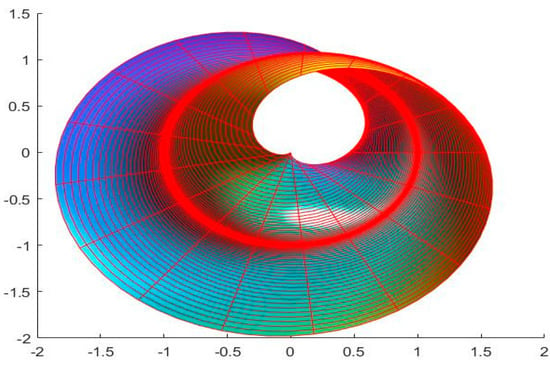
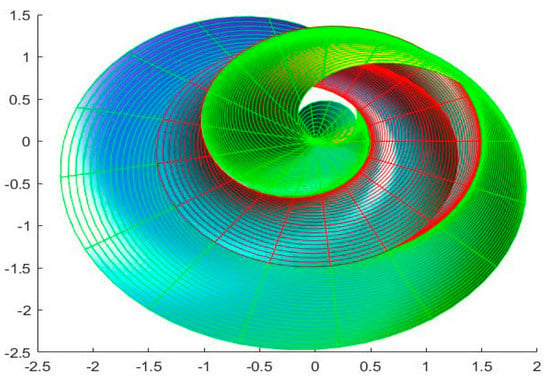
Taking the profile curves as and in Figure 1 and Figure 2, the twisted surface (23) and the conchoidal twisted surface (24) which points are for and , , becomes and

Figure 1.
Twisted surface .

Figure 2.
Conchoidal Twisted surface .
Example 2.
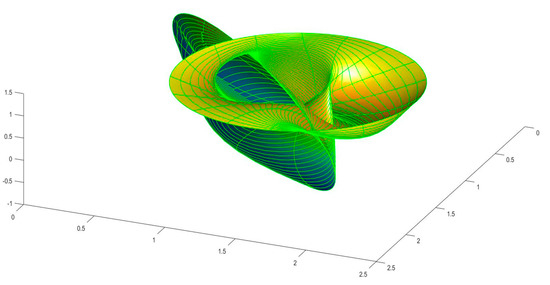
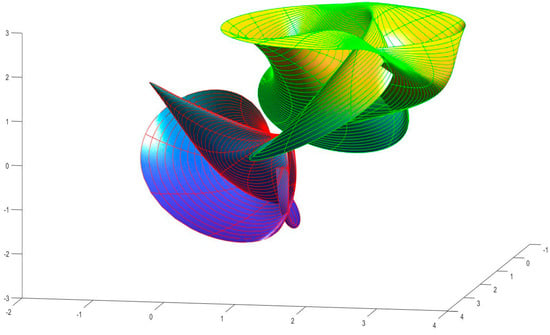
Let us take the profile curves as and , the twisted surface in (42) and the conchoidal twisted surface in (43) formed by the involute of the curve and which points are for and , , , becomes
where the coefficients and see in Figure 3 and Figure 4.

Figure 3.
The twisted surface formed by the involute of the curve .

Figure 4.
The conchoidal twisted surface formed by the involute of the curve .
Additionally, taking the coefficients and the conchoidal twisted surface formed by the involute of the curve is obtained by
Example 3.
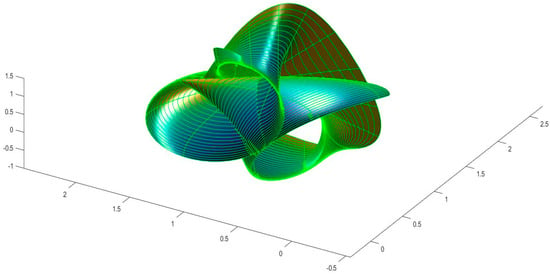
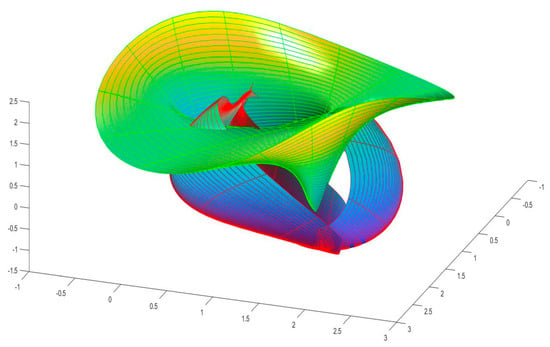
Let us take the profile curves as and , the twisted surface in (45) formed by the Bertrand curve pair of which points in Figure 5 are for , , , becomes
where , in Theorem 3.

Figure 5.
The twisted surface with Bertrand curve pair .
The conchoidal twisted surface in (46) formed by the Bertrand curve pair of
which points are
for
,
,
,
,
becomes
where the coefficients in Theorem 3 are , see in Figure 6.

Figure 6.
Conchoidal twisted surface with Bertrand curve pair .
5. Conclusions
In this study, some basic definitions were given for creating twisted and conchoidal twisted surfaces. The first and second fundamental forms of the conchoidal twisted surface were computed. Then, the Gaussian and mean curvature of the conchoidal twisted surface were calculated. Additionally, the conchoidal twisted surfaces formed by an involute curve and a Bertrand curve pair were defined.
Author Contributions
Conceptualization, S.Ç. and H.K.S.; methodology, H.K.S.; software, S.Ç.; validation, S.Ç., H.B.K. and H.K.S.; formal analysis, S.Ç.; investigation, S.Ç. and H.K.S.; resources, S.Ç.; data curation, H.K.S.; writing—original draft preparation, S.Ç. and H.K.S.; writing—review and editing, H.B.K.; visualization, S.Ç.; supervision, H.K.S. and H.B.K.; project administration, H.K.S.; funding acquisition, S.Ç., H.B.K. and H.K.S. All authors have read and agreed to the published version of the manuscript.
Funding
This research received no external funding.
Data Availability Statement
Our manuscript has no associated data.
Conflicts of Interest
The authors declare no conflict of interest.
References
- Eisenhart, L.P. An Introduction to Differential Geometry; Princeton University Press: Princeton, NJ, USA, 1940. [Google Scholar]
- Fuchs, D. Evolutes and Involutes of Spatial Curves. Am. Math. Mon. 2013, 120, 217–231. [Google Scholar] [CrossRef]
- Hacısalihoğlu, H.H. Differential Geometry; Academic Press Inc.: Ankara, Turkey, 1994. [Google Scholar]
- Sabuncuoğlu, A. Differential Geometry; Nobel Yayın Dağıtım: Ankara, Turkey, 2010. [Google Scholar]
- Sun, J.; Zhao, Y. The Geometrical Characterizations of the Bertrand Curves of the Null Curves in Semi-Euclidean 4-Space. Mathematics 2021, 9, 3294. [Google Scholar] [CrossRef]
- Alluhaibi, N.; Abdel-Baky, R.A.; Naghi, M. On the Bertrand Offsets of Timelike Ruled Surfaces in Minkowski 3-Space. Symmetry 2022, 14, 673. [Google Scholar] [CrossRef]
- Lockwood, E.H. A Book of Curves; Cambridge University Press: Cambridge, UK, 1961. [Google Scholar]
- Sendra, J.R.; Sendra, J. An algebraic analysis of conchoids to algebraic curves. AAECC Appl. Algebra Eng. Commun. Comput. 2008, 19, 413–428. [Google Scholar] [CrossRef]
- Peternell, M.; Gruber, D.; Sendra, J. Conchoid surfaces of rational ruled surfaces. Comput. Aided Geom. Des. 2011, 28, 427–435. [Google Scholar] [CrossRef]
- Bulca, B.; Oruç, S.N.; Arslan, K. Conchoid curves and surfaces in Euclidean 3-Space. Balıkesir Univ. J. Grad. Sch. Nat. Appl. Sci. 2018, 20, 467–481. [Google Scholar] [CrossRef]
- Oruç, S.N.; Oruç, A. Characterization of Conchoid Curves and Surfaces in Euclidean Spaces. Master’s Thesis, Uludağ University, Graduate School of Natural and Applied Sciences, Bursa, Turkey, 2019. [Google Scholar]
- Dede, M. Spacelike Conchoid curves in the Minkowski plane. Balk. J. Math. 2013, 1, 28–34. [Google Scholar]
- Aslan, M.Ç.; Şekerci, G.A. An Examination of The Condition Under Which A Conchoidal Surfaces is A Bonnet Surface in the Euclidean 3-Space. Facta Univ. Ser. Math. Inform. 2021, 36, 627–641. [Google Scholar] [CrossRef]
- Ikawa, T. Bour’s theorem and Gauss map. Yokohama Math. J. 2000, 48, 173–180. [Google Scholar]
- Goemans, W.; Ignace, V.W. Twisted Surfaces in Euclidean and Minkowski 3-Space. In Proceedings of the PADGE 2012, Leuven, Belgium, 27–30 August 2012; Shaker Verlag: Aachen, Germany, 2013. [Google Scholar]
- Goemans, W.; Ignace, V.W. Constant curvature twisted surfaces in 3-dimensional Euclidean and Minkowski 3-space. In Proceedings of the Conference RIGA; Publishing House of the University of Bucharest: Bucharest, Romania, 2014; pp. 117–130. [Google Scholar]
- Gray, A.; Abbena, E.; Salamon, S. Modern Differential Geometry of Curves and Surfaces with Mathematica; Chapman and Hall/CRC: Boca Raton, FL, USA, 2017. [Google Scholar]
- Dolaşır, S. The Properties of the Twisted Surface. Master’s Thesis, Uşak University, Uşak, Turkey, 2018. [Google Scholar]
- Kazan, A.; Karadağ, H.B. Twisted surfaces in the Pseudo-Galilean space. New Trends Math. Sci. 2017, 5, 72–79. [Google Scholar] [CrossRef]
- Dede, M.; Ekici, C.; Goemans, W.; Ünlütürk, Y. Twisted surfaces with vanishing curvature in Galilean 3-space. Int. J. Geom. Methods Mod. Phys. 2018, 15, 1850001. [Google Scholar] [CrossRef]
Disclaimer/Publisher’s Note: The statements, opinions and data contained in all publications are solely those of the individual author(s) and contributor(s) and not of MDPI and/or the editor(s). MDPI and/or the editor(s) disclaim responsibility for any injury to people or property resulting from any ideas, methods, instructions or products referred to in the content. |
© 2023 by the authors. Licensee MDPI, Basel, Switzerland. This article is an open access article distributed under the terms and conditions of the Creative Commons Attribution (CC BY) license (https://creativecommons.org/licenses/by/4.0/).